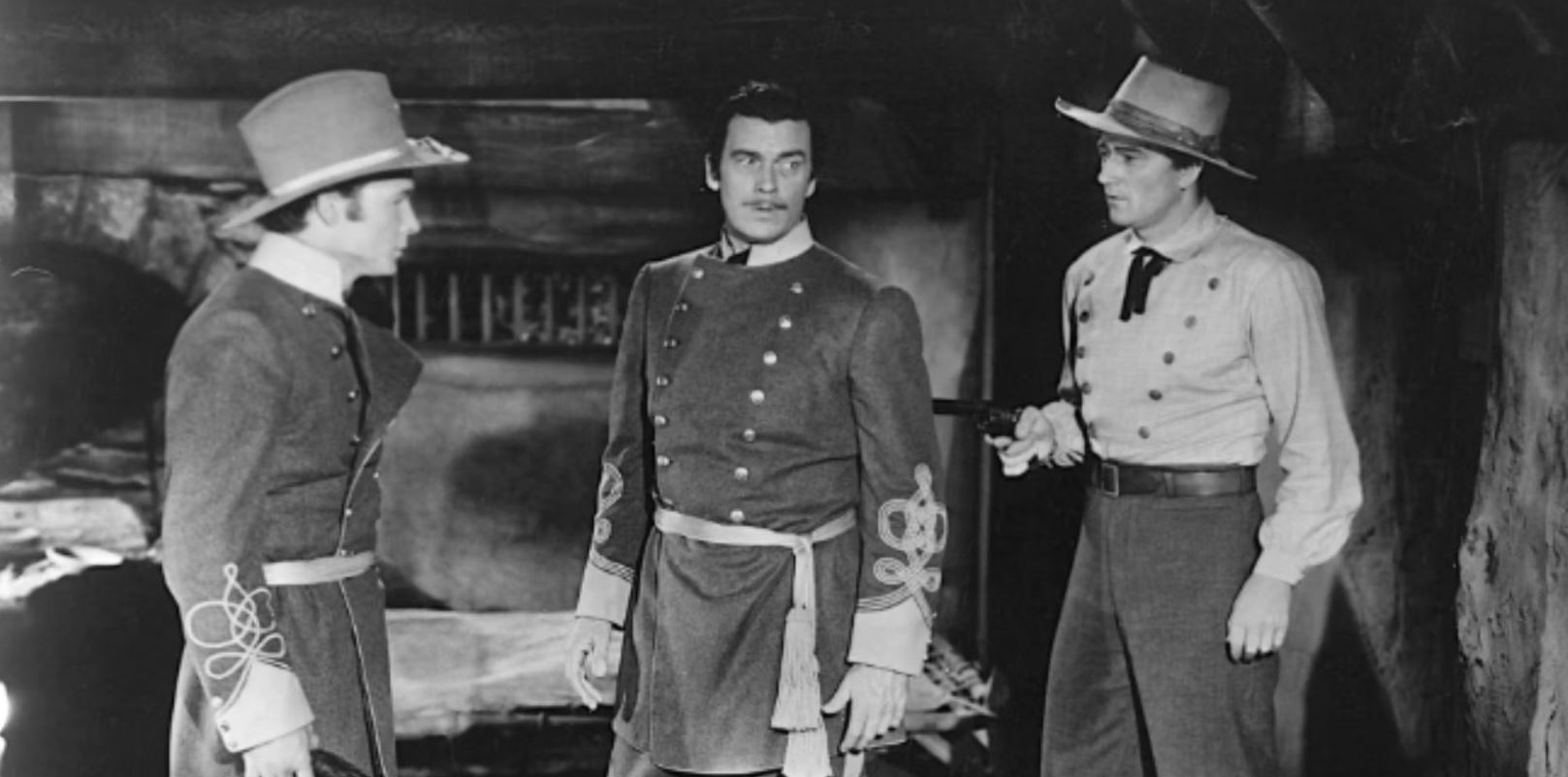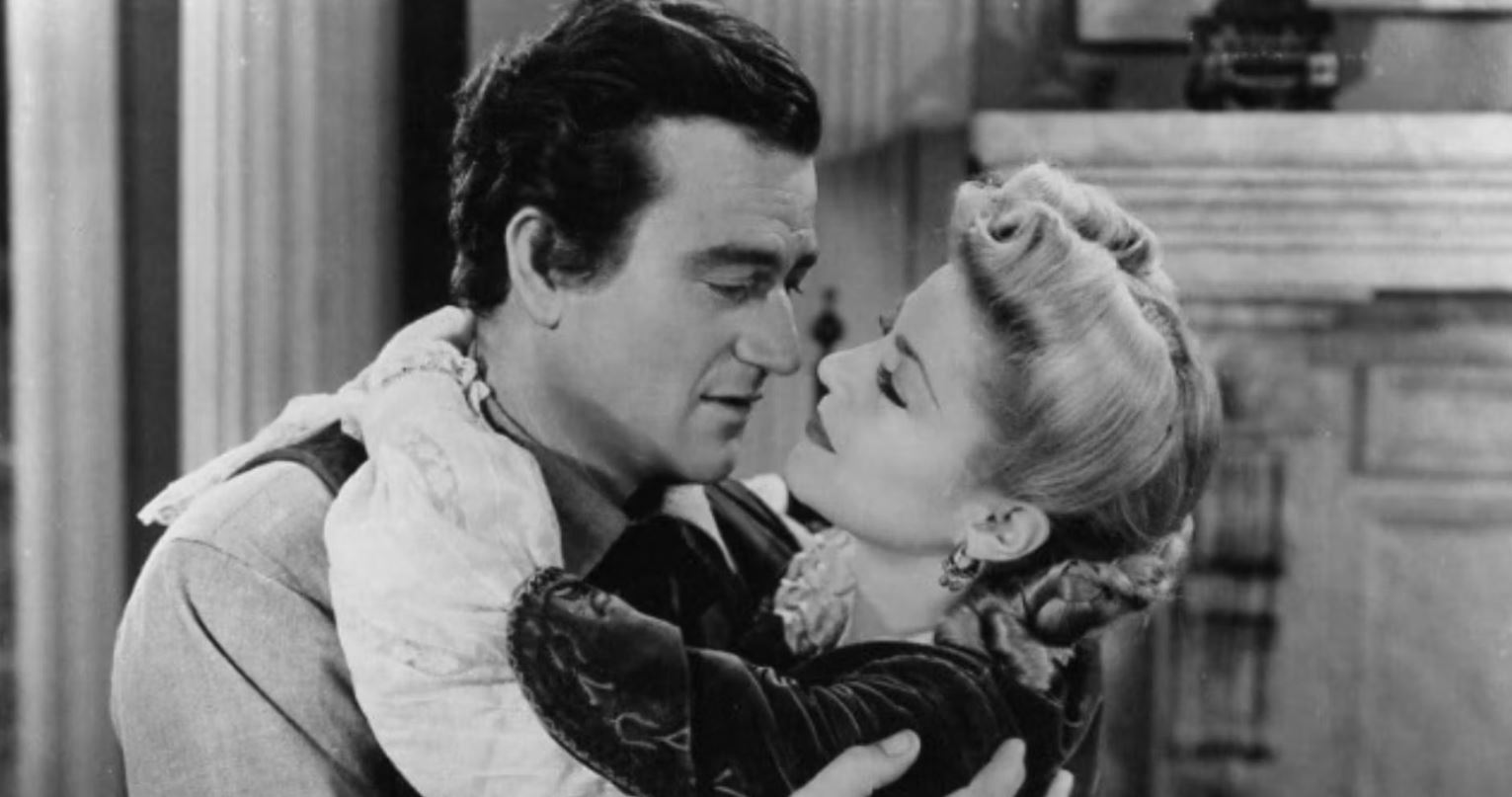Before John Wayne became a staple name that we associate with Westerns, he was just Marion Robert Morrison, or to those close to him, his childhood moniker, Duke. It was the legendary director Raoul Walsh who spotted him as a prop man carrying furniture across soundstages who laid the ground for his fame. Handing him his first big lead role in the 1930 Western The Big Trail, Walsh would also be the one who gave him the iconic name John Wayne. It would be a decade before the two greats would collaborate again, this time on the unflinching, Oscar-nominated crime Western Dark Command. The movie is an adaptation of William Riley Burnett’s 1938 novel of the same name. It is in Dark Command, which is partly inspired by a true story, that Wayne would team up with another fine talent of his generation, “the King of the Cowboys,” singer, actor, radio, and television star Roy Rogers, in their only cinematic collaboration.
Like John Wayne, Roy Rogers — who would also go on to be a singer, radio, and television star — had a similarly not-so-flashy beginning to his illustrious acting career, and he appeared in a number of movies billed as his birth name, Leonard Slye. Much like Wayne’s journey, where Fox Studios demanded the adoption of a new stage name, Leonard Slye would face the same fate at Republic Pictures, with the studio eventually settling on the name Roy Rogers, partly as a shout-out to the renowned actor-humorist Will Rogers. John Wayne and Roy Rogers would ascend to the zenith of Hollywood, particularly leaving an indelible mark on the Western genre. However, it was in Dark Command that two of cinema’s golden boys had their only meet up and glistened on the silver screen, providing a strong foundation for their future artistic magic.
What’s ‘Dark Command’ About?

Set against the background of the North and South politics of the Civil War, Dark Command follows Bob Seton (John Wayne), a Texan dreamer who’s fallen in love with his new town, Lawrence, Kansas, and especially its girl, Mary McCloud (Claire Trevor). Roy Rogers’ character, Fletcher, is a brother to Mary. Bob dislikes the divisive politics that the period provides, but more so the town’s prevalent lawlessness. Sharing the same ideology, John Wayne’s and Roy Rogers’ characters inadvertently team up in a Bad Boys-esque way to teach street crooks a lesson about manners. Though illiterate, Wayne’s Bob is driven by the desire for a more just society and decides to contest for the vacant Marshal’s position. Taking up adult literacy classes, he discovers that the town’s popular, charismatic teacher, William Cantrell (Walter Pidgeon), with whom he plans on enlisting the classes, is also in the race for the Marshal’s job.
To complicate matters for Bob, his main attraction in the new town, Mary, is the teacher’s fiancée. While luck is on his side as he wins the first round of challenges, the outbreak of the Civil War provides an opportunity for his competitor to go rogue. Based on the true story of the infamous criminal William Clarke Quantrill of the Quantrill’s Raiders, the Dark Command’s villain commits despicable atrocities against citizens. Bob has to face off with him for love and justice for his people. Dark Command covers violent exploits, including arson, murder, corruption, and terror against townsfolk, painting a grim picture of survival in the Old West.
But it’s not all gloomy in Dark Command. Even in its cruelty, the film has its fair share of light moments, with John Wayne’s screen sidekick George Francis “Gabby” Hayes playing a quirky dentist who provides a heavy dose of comic relief. Hayes would become Roy Rogers’ trusted collaborator in subsequent films. In Dark Command, Hayes’ archetypal waggish character makes us, for a moment, forget about the dozens of people Cantrell is massacring and the buildings he is setting ablaze. Dark Command weaves a compelling narrative into the naked realities of ambition, loyalty, and justice. The film’s plot centers on the principles or values on the one hand and the seductive power of control on the other. As Bob Seton transforms from idealistic newcomer to resolute figure of authority, his unwavering pursuit of justice stands in stark contrast to William Cantrell’s descent into ruthless criminality. The film skillfully explores the tension between lawlessness and order. This theme becomes particularly emblematic because Bob’s unwavering determination represents the ongoing struggle for fairness and justice.
John Wayne & Roy Rogers’ Characters Clash in ‘Dark Command’

As Bob Seton, John Wayne’s clamor for justice in Dark Command is relentless. He stands tall against a hostile array of odds. He arrives in Lawrence, Kansas, as a thought-provoking Texan dreamer looking for a better personal life and a more equitable society, and ends up as the town’s Marshal. His character arc from a half-baked tenderfoot on his arrival to taking up civic duty and becoming a trusted, steadfast figure of authority symbolizes the ideal American dream. That regardless of your origins, you can make it anywhere in the nation through hard work, determination, and relentless pursuit of self-improvement. His conflict with the charismatic, albeit depraved, William Cantrell further underlines his moral fiber.
While Cantrell pillages, Bob sticks to his guns and draws a line that marks the demarcation between righteousness and lawlessness. Nothing, not even his love interest, Mary, can take his focus away from dispensing justice. This is apparent when he fails to give in to Mary’s request for a clandestine justice process in favor of her brother when he brushes shoulders with the law. As Bob, John Wayne brings an inspiring presence into the film that only he could do.
In contrast, Roy Rogers’ Fletcher goes through a tumultuous journey where his ideals are put to the test. His naivety and uncontrolled temperament are his undoing. He easily draws a gun on an unarmed person at the slightest provocation, which lands him in trouble, and then blindly follows his brother-in-law to cause anarchy. Initially showing an uncheckered ideology similar to Bob’s, Fletcher’s arc explores how, in times of crisis, the line between evil and good can blur. As Cantrell’s influence grows, Fletcher finds himself ensnared in a web of deceit, believing he is fighting for a just cause. While Dark Command provides an opportunity for his redemption, the clash between Bob’s unyielding resolve and Fletcher’s shaken ideals draws rich tension in Dark Command.
‘Dark Command’ Provided John Wayne & Roy Rogers With a Foundation For Future Roles

Dark Command followed on the heels of the first of John Wayne’s successful collaborations with Claire Trevor in the period masterpiece — from the masterly direction of John Ford himself — Stagecoach, which gave us some of John Wayne’s coolest minutes on-screen. Dark Command continued to further engrave the archetype of a Western hero, which would be famously portrayed by John Wayne in later films. Like his portrayal of Bob Seton, Wayne’s future characters, depicting resilience, moral fortitude, and pursuit of justice during difficult times, would become a blueprint for his roles. In the classic The Searchers, we see a war-scarred John Wayne relentlessly seeking justice for the murdered and abducted members of his community. In Dark Command, too, John Wayne as a hopeless romantic Bob gives us a side we rarely see in his later films. But when we see him smitten in The Quiet Man, we understand the foundation of it. John Wayne’s blend of toughness and vulnerability in Dark Command helped solidify his persona as the quintessential Western hero.
On his part, Roy Rogers’ Fletcher displays a glimpse into the complex roles he would imbue with his overflowing talents. In Dark Command, “The King of the Cowboys” doesn’t sing, unlike in his other renowned roles. In this film, he delves into the themes of naivety and moral ambiguity, which lays the groundwork for his nuanced performances in later films, like King of the Cowboys, in which he goes undercover, and the 1950 Western Trigger, Jr., starring alongside his famous horseTrigger.
A classic Western, Dark Command is a gripping narrative with powerful performances. The film was critically acclaimed, though for a movie that is partly based on true events, it falls short on some basic historical accuracy, like Dodge City being mentioned, yet the film is set at the onset and during the Civil War, long before Dodge City was founded. However, with John Wayne’s steadfast pursuit of justice and Roy Rogers’ morally complex character arc, the film offers a thrilling, emotionally charged experience. A largely good-versus-evil film, Dark Command was nominated for two Academy Awards, for Victor Young’s music score and John Victor Mackay’s art direction. For its unflinching portrayal of the American frontier, with all its good, the bad, and the ugly, Dark Command is a worthy watch.
